In this continuation of blogs about the corundum gem varieties, sapphire and ruby, I will first describe the trade routes that first brought the gems, from their mines in the East, to the Roman Empire, then to the rest of Europe. I will also present a gallery of ruby jewelry and artworks designed and made by artisans of the Grecian and Roman Empires and those of the Victorian Era, as well.
ANCIENT SOURCES AND TRADE ROUTES OF SAPPHIRES AND RUBIES FROM EAST TO WEST
As shown in Table I, sapphires and rubies were mined in the East, before 543 BC in what is now Sri Lanka; before 600 AD in what is now Myanmar; before 951 AD in Afghanistan; before 1408 AD in what are now Thailand and Cambodia. Mining began in 1879 in the Kashmir province of India. Interestingly the mines in the East were the sole sources of sapphires and rubies until the discovery of these gems in Madagascar.
The overland and maritime routes of the Silk Road between the East and West served to bring sapphires and rubies from their sources in the East to the Mediterranean, and particularly to coastal cities of the Roman Empire [Ref 1, Ref 2]. The relationship of the port locations serving the Silk Road, to the sources of the gems, are shown in Figure 1. As seen in the figure, sources of rubies and sapphires in what is now Thailand, Cambodia and Sri Lanka, were in close proximity to the ports serving the maritime routes. Trade along the Silk Road, beginning in 2 BC, provided sapphire and ruby gemstones to the Etruscan and Roman Empires, as well as to Europe, later on. Both overland and maritime routes also served to bring the gemstones to the Mughal Empire in what are now India, Pakistan, and Afghanistan.

TABLE I. ANCIENT AND MODERN SOURCES OF SAPPHIRES AND RUBIES
| DATE | SOURCE | REMARKS |
| Before 543 BC [Ref 1,2,3] | Sri Lanka | Gemstones appeared in Etruscan jewelry (700 BC to late 4th Century BC). |
| Before 600 AD [Ref 1] | Myanmar (Burma) | Mentioned in ancient legends. Europeans reported source in 15th century. |
| Before 951 AD [Ref 1] | Afghanistan | Ruby mines on border with Tajikistan since 10th century. |
| Before 1408 AD [Ref 1,4] | Thailand/Cambodia | More sapphire and ruby deposits in Thailand than in Cambodia |
| 1879 [Ref 5] | Kashmir State, India | Blue sapphires discovered in Padar region. |
| After 1891 [Ref 1] | Madagascar | Sapphire and ruby occurances first described in 1547. |
| 1895 [Ref 6] | Yogo Gulch, Montana, USA | Noted for deep blue color |
| 1950 [Ref 1] | Tanzania | Ruby deposits still being discovered. |
| 1973 [Ref 1] | Kenya | Most important deposit near Mangari in SE Kenya. |
| 1970’s [Ref 1] | Vietnam | First major discovery in province of Luc Yen. Major commercial mining began 1980’s. |
|
2008 [Ref 1]
| Mozambique | Deposit found near Zambia border. |
GALLERY OF ANCIENT RUBY JEWELRY AND ART OBJECTS
In a search of the web for examples of ancient ruby jewelry and art objects from the Roman and Hellenistic Era to the Victorian Era, I found a dearth of examples of ruby jewelry, in contrast to finding examples of both sapphire and garnet jewelry. Studies from ancient sources show that ruby jewelry was extremely rare and that the red garnet was the most popular gem in the Helenistic Era, but somewhat less popular in the Roman empire [Table, PP 175-176 Ref 1].
Accordingly this gallery presents examples of ruby jewelry and art works from the Medieval Era [Ref 9] to the Victorian Era
Medieval Era


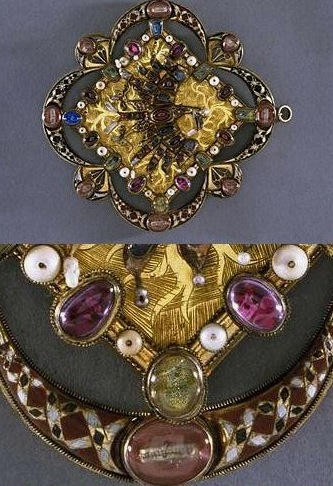
Bohemian(?) mid-14th century [Ref 13].
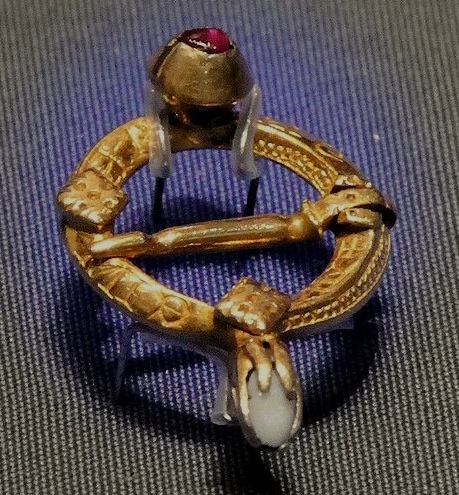
Renaissance Era [Ref 15]

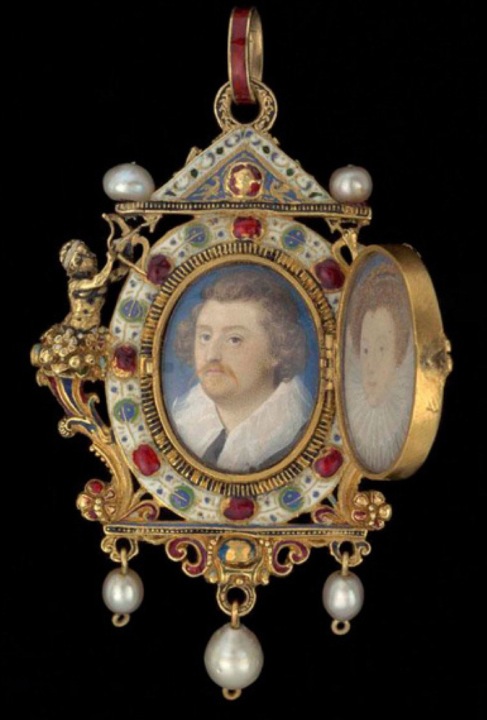
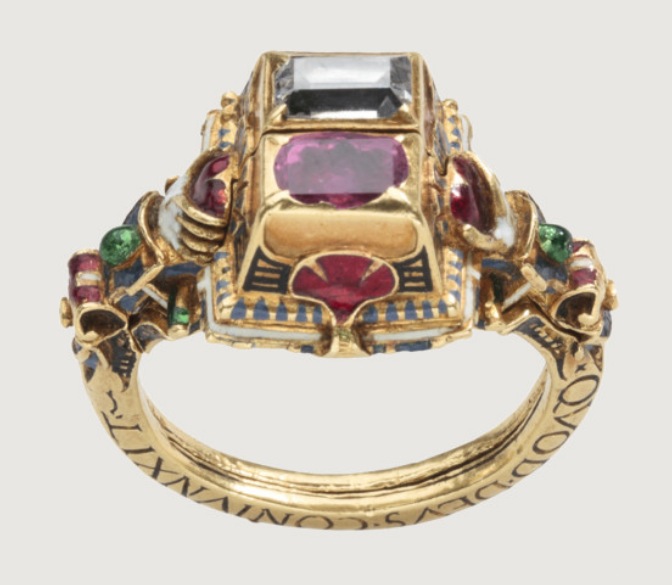
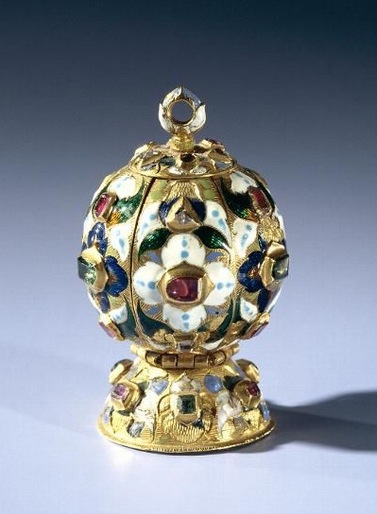

Victorian Era [Ref 21]

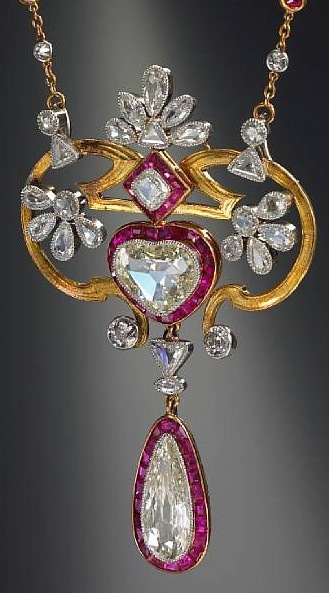
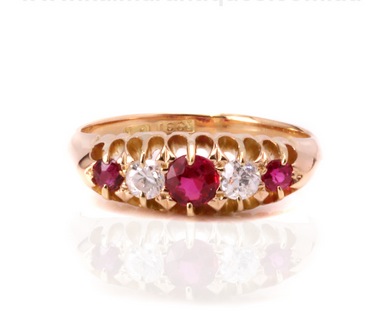
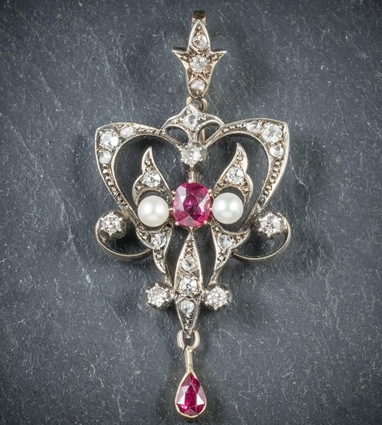
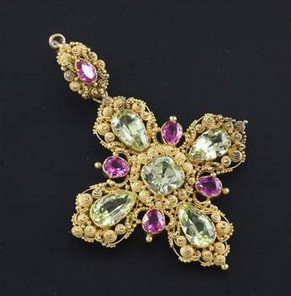
green sapphires with cannaetille work, late Victorian Era [Ref 27, Ref 28].

REFERENCES
Ref 2. http://studiopjj.blogspot.com/2007/05/east-and-west-ancient-gem-trade-between.html
Ref 3. https://www.langantiques.com/university/Ruby
Ref 4. https://en.wikipedia.org/wiki/Etruscan_civilization
Ref 7. http://www.ruby-sapphire.com/r-s-bk-india.htm
Ref 8. https://gemgallery.com/yogo-sapphire-gemology
Ref 9. https://en.wikipedia.org/wiki/Middle_Ages
Ref 10. https://www.pinterest.com/pin/89931323788019900/
Ref 11. https://en.wikipedia.org/wiki/Crown_of_Princess_Blanche
&
Ref 12. https://en.wikipedia.org/wiki/Blanche_of_England
Ref 13. https://www.pinterest.com/pin/155937205834052921/
Ref 14. https://www.pinterest.com/pin/155937205826166727/
Ref 15. https://en.wikipedia.org/wiki/Renaissance
Ref 16. https://www.britannica.com/art/jewelry/The-history-of-jewelry-design
Ref 17. https://theframeblog.com/category/16th-17th-century/
Ref 19. https://en.wikipedia.org/wiki/Gimmal_ring
Ref 20. https://www.pinterest.com/pin/370772981794628769/?lp=true
Ref 21. https://www.pinterest.com/pin/335799715956345727/
Ref 22. https://en.wikipedia.org/wiki/Victorian_era
Fig. 23. https://www.pinterest.com/pin/151574343680238550/
Fig 24. http://www.alaintruong.com/archives/2008/10/12/10923843.html
Ref 25. https://www.kalmarantiques.com.au/product/antique-ruby-and-diamond-ring-made-in-the-victorian-era/
Ref 28. https://www.langantiques.com/university/Cannetille
Ref 29. https://en.wikipedia.org/wiki/Dutch_East_India_Company



